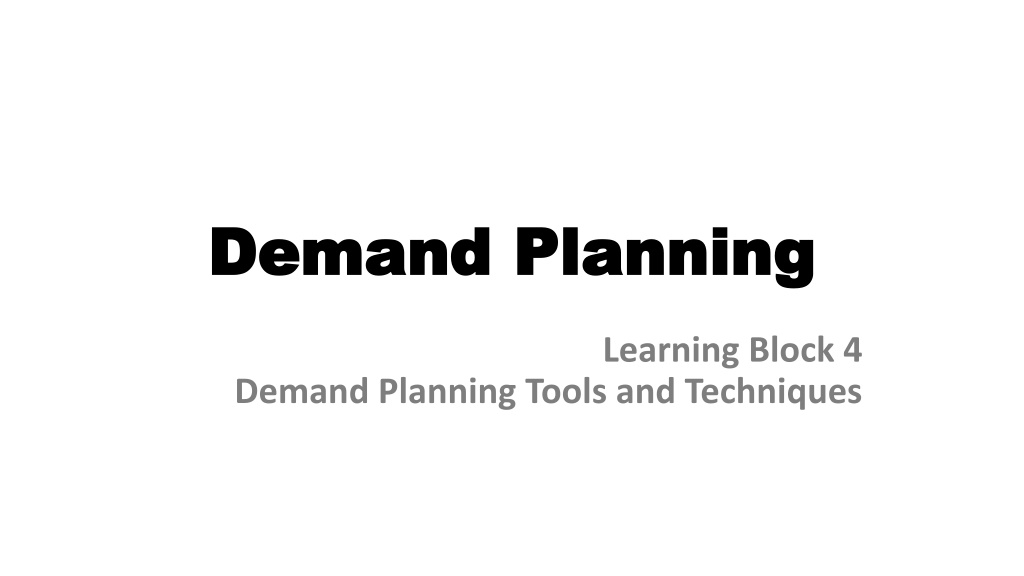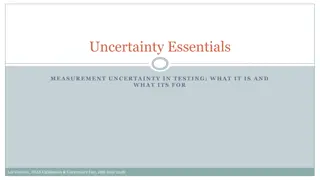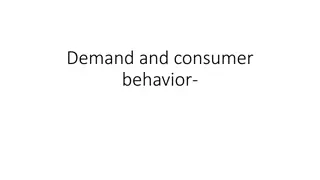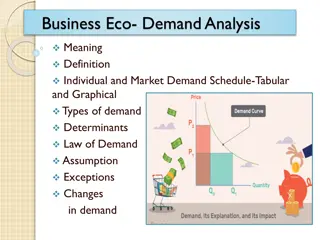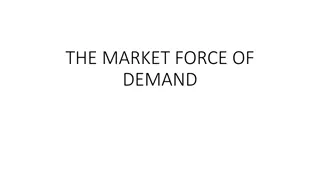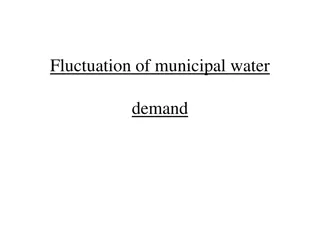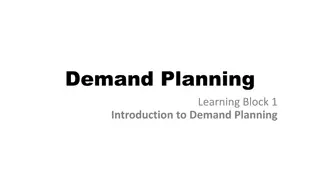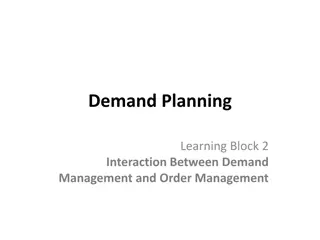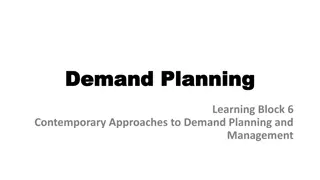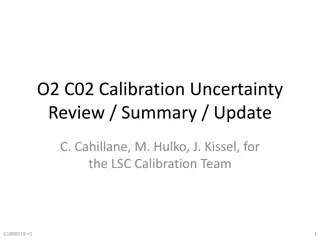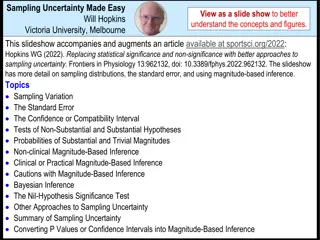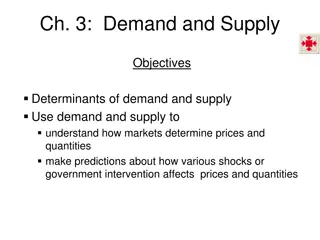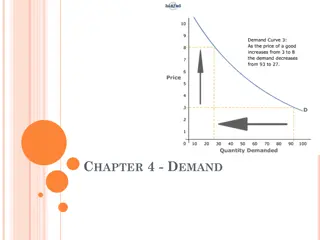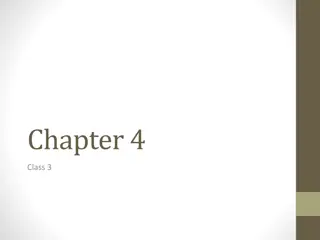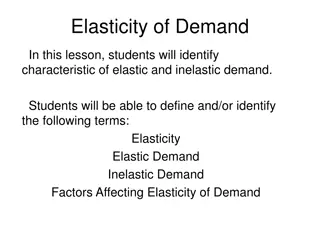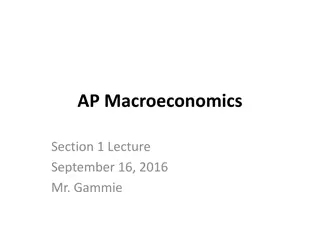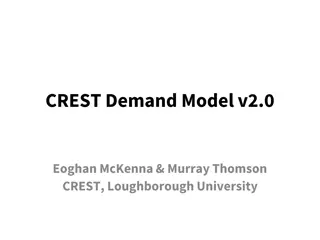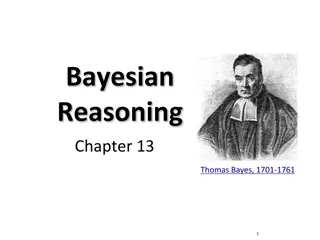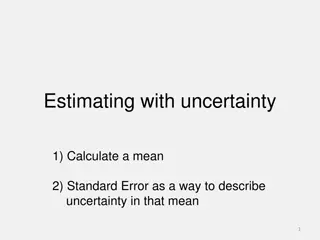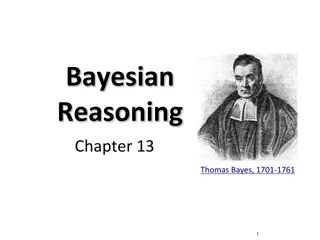Managing Uncertainty in Demand Planning: Tools and Techniques
Uncertainty in demand planning can lead to inefficiencies in the supply chain. This course covers various tools and techniques to manage demand, supply, and lead time variability, reducing costs and optimizing operations. Learn to recognize and address causes of uncertainty, apply forecasting techniques, and enhance supply chain concepts for efficient demand planning.
Download Presentation

Please find below an Image/Link to download the presentation.
The content on the website is provided AS IS for your information and personal use only. It may not be sold, licensed, or shared on other websites without obtaining consent from the author. Download presentation by click this link. If you encounter any issues during the download, it is possible that the publisher has removed the file from their server.
E N D
Presentation Transcript
Demand Planning Demand Planning Learning Block 4 Demand Planning Tools and Techniques
Course Agenda Course Agenda 1. Introduction to Demand Planning 2. Interaction between Demand Management and Order Management 3. Demand Planning Principles 4. Demand Planning Tools and Techniques 5. Communicating and Managing Demand 6. Contemporary Approaches to Demand Planning and Management 2
Demand Planning Tools and Demand Planning Tools and Techniques Techniques Learning Block 1
Learning Block Agenda Learning Block Agenda Unit 1: Uncertainty in Demand Planning Unit 2: Addressing Causes of Uncertainty and Variability Unit 3: Tools and Techniques to Reduce Uncertainty
Description Description Uncertainty can result from even the best demand planning processes, along with tools and techniques to manage demand, supply, and lead time variability. Variability tends to be costly for companies in the supply chain, so this learning block also includes ways to minimize variability and reduce costs. Lastly, this learning block reviews other supply chain concepts, such as safety stock, reorder points, and order quantities. 5
Learning Objectives Learning Objectives Recognize the various types of uncertainty related to demand planning in terms of demand, supply, and lead times Explain the causes and impacts of variability or uncertainty Apply the basic types of forecasting techniques, such as reorder points, economic order quantity (EOQ), lead times, and technology uses
Unit 1: Uncertainty in Demand Planning Unit 1: Uncertainty in Demand Planning Uncertainty is the quality or state of being uncertain, or something that is itself unknown. In the case of demand planning, uncertainty occurs in demand, supply, and lead time. While demand can be forecasted, it is virtually impossible to know exactly what will be needed to meet customer requirements.
UNCERTAINITY IN DEMAND PLANNING Uncertainty in Demand Not knowing the precise amount that will be needed. Uncertainty in Supply Due to the instability of suppliers, potential shortages in raw materials, or reliability of transportation. Uncertainty in Lead Time Result of differing processing times, picking times, and shipping or transportation times.
Unit 2: Addressing Causes of Uncertainty and Unit 2: Addressing Causes of Uncertainty and Variability Variability VARIABILITY is the range of possibilities or outcomes for a specific situation. Uncertainty can lead to variability in the supply chain. If companies understand the causes of variability and counteract or plan for those causes, they can work on reducing variability.
COLLABORATIVE PLANNING, FORECASTING, AND REPLENISHMENT (CPFR) CPFR includes sharing sales data and forecasts and any other known issues that might affect the supply chain. (We will learn more about this in Learning Block 6) If companies can obtain customers actual demand for their products, they can prepare to meet those needs more efficiently. This can be achieved by electronically sharing demand data in real time.
IMPACT OF VARIABILITY Increase in operating costs Increased levels of inventory
SAFETY STOCK Safety stock is the additional inventory that is needed to cover variability or uncertainty. It is also referred to as buffer stock, because it is a buffer against uncertainty
Unit 3: Tools and Techniques to Reduce Uncertainty Unit 3: Tools and Techniques to Reduce Uncertainty Statistical Forecasting Techniques Point Logic In Replenishment EOQ Lead Time Analysis Role Of Technology
1. STATISTICAL FORECASTING TECHNIQUES Simple moving average: Historical data are used to predict a future demand need Weighted moving average: Place more weight or emphasis on some time periods than on others. Usually, more weight is placed on the most recent sales, and less weight is placed on older sales.
ONE PROBLEM- TWO WAYS January sales: 200 units (Weight=10%) February sales: 300 units (Weight=30%) March sales: 400 units (Weight=60%) * Most recent WEIGHTED MOVING AVERAGE SIMPLE MOVING AVERAGE = (0.6 x 400)+(0.3 x 300)+ (0.1 x 200) =(200+300+400)/3 = 300 units = 350 units
TWO OTHER TYPES OF FORECAST METHODS Causal Forecasts Use specific factors to determine future demand Expert Forecasts Use inputs from subject matter experts (SMEs) to generate forecasts
2. REORDER POINTS The reorder point occurs once the inventory of an item reaches a predetermined level that sets off a new order to replenish the level to a predefined quantity.
FIXED ORDER QUANTITY FIXED ORDER INTERVAL Fixed order quantity occurs when the same amount of product is reordered in every instance, but the order timing varies. Fixed order interval approach occurs when the amount ordered varies, but the time between orders remains the same. For each product, the inventory level is noted when reorder time arrives.
Which reorder point technique is best? Fixed order quantity approach is usually applied to items that are more critical or characterized as an A item in the ABC classification. Fixed order interval approach is more suitable for B and C items because they do not need to be monitored as often, which saves time and thus money.
3. ECONOMIC ORDER QUANTITY (EOQ) EOQs help companies determine how much to reorder for the fixed quantity model. The EOQ determines the best quantity to order for replenishment that balances costs of ordering in a procurement process and setup costs in a manufacturing environment. EOQ is calculated by using the amount of procurement costs and the carrying costs. According to Coyle et al. (2003), EOQ is calculated with the formula: ??? ?? Where R is annual demand, A is cost per order or cost per machine setup, V is value of the item, and W is inventory carrying cost percentage.
ASSUMPTIONS OF EOQ MODEL Demand rates that are continuous, constant, and known, such as 100 units Replenishment lead times that are constant and known, such as three days That all demand will be satisfied by the quantity ordered; for example, 100 units will cover demand until the next order Costs per unit purchased and transportation costs remain the same, no matter what quantity is purchased
Figure 16. Graph A: The order cost decreases as the quantity increases; at the same time, the holding costs increase as the quantity increases. The combined cost shows the lowest cost when taking both into account. Developed by LINCS in Supply Chain Management Consortium.
Calculating EOQ For a gym equipment dealer, the annual demand for gym mats is 3,600 per year, and each gym mat costs $100. The annual holding cost per unit is 25%, and the cost to place an order from the gym mat supplier is $200. Using the information in this example, the values used in the formula would be as follows: V = $100 per unit W = 25% (or 0.25 in the formula) A = $200 per order R = 3,600 units per year 2 3600 200 100 0.25 The EOQ in this case is the square root of (1,440,000/25), or 240 gym mats. This means that the EOQ using the fixed quantity model is 240 gym mats.
4. LEAD TIME ANALYSIS Lead time analysis involves analyzing the various components of lead time to see if the times required can be reduced or if each component can be made more consistent in order to minimize uncertainty. Components of lead time: Time taken to receive an order Time to transmit an order to a supplier or to a warehouse Time to prepare or pick an order in a warehouse Time to pack an order Time to transport an order to a customer.
5. ROLE OF TECHNOLOGY Forecasting software for demand planning uses built-in statistical models to forecast sales and demand based on the use of extensive data about past sales, helping to provide a more accurate idea of what to expect in the future.
Summary Summary
PRACTICE QUESTIONS 1. Which is not a component of lead time? a) Order transmittal b) Order preparation c) Order receipt d) Marketing forecasts 2. Which replenishment method results in the same amount of product being ordered each time? a) Safety stock b) Fixed order interval c) Fixed order quantity d) Moving average
PRACTICE QUESTIONS 3. What type of forecasting technique emphasizes certain time periods over others? a) Linear regression b) Simple moving average c) Weighted moving average d) Expert forecast 4. Which of the following is NOT an assumption used to calculate EOQ? a) A changing rate of demand over time b) A constant and known replenishment c) The satisfaction of all demand d) A constant cost that is independent of the order quantity or time
PRACTICE QUESTIONS 5. What is the benefit of using specialized demand planning software? a) It enables software companies to increase sales b) It is better for predicting causal forecasts c) There are built-in statistical models to forecast sales and demand d) It eliminates the need for demand planning personnel 6. EOQ balances the costs of ordering with: a) Inventory carrying costs b) Procurement costs c) Inventory ordering costs d) Manufacturing costs
PRACTICE QUESTIONS 7. Which of the following inventory review approaches is best for fast-selling items? a) Lead time analysis b) Fixed order interval c) Fixed order quantity d) Safety stock analysis 8. Businesses have to carry ____________________ because there are variations in demand, supply, and lead time. a) Safety stock b) Obsolescence stock c) Seasonal stock d) Raw Materials
PRACTICE QUESTIONS 9. What can be calculated by multiplying daily demand by the length of the lead time? a) Reorder point quantity b) EOQ c) Order processing time d) Picking time 10. What might a manufacturing company need to have as additional inventory if there is a problem with late supplier deliveries? a) Finished goods b) Raw materials c) Work in process inventory d) Reorder point
